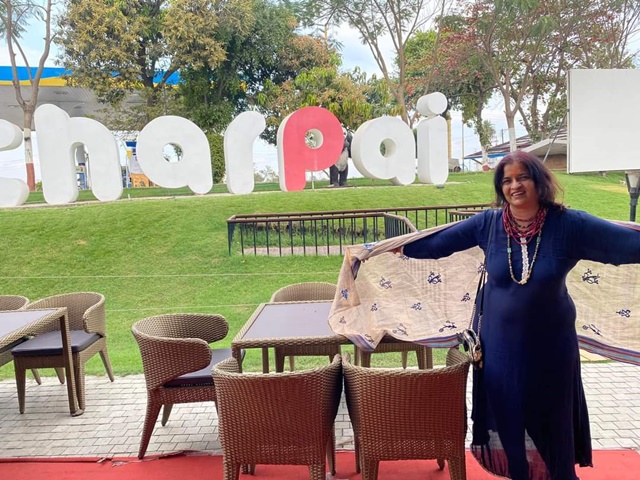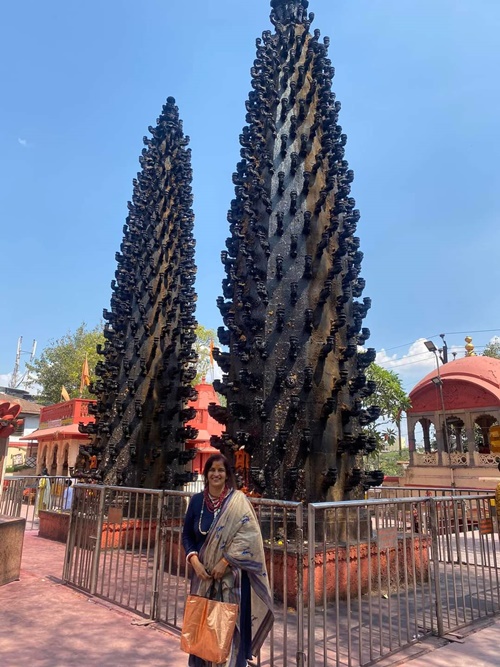By Shobha Rao Smilemaker
Mar 18: I was really looking forward to visit Ujjain which is considered as one of the 7 holy ancient cities that can provide salvation. It attracts many like me to see one of the 12 sacred Jyothirlingas. It is one of the 4 cities where the Kumbh mela event takes place. It is also the place which has one of the 51 Shakti peets of Devi.
We entered the narrow streets on the day of Holi and it was thrilling to watch the locals throw colour and water on each other outside their homes, giving me such a good feeling about their community bonding.
We first had to enter the Ujjain Corridor, an ambitious project to display the different stories and avatars of Lord Shiva. We walked past 108 sandstone pillars carved with Shiva images on one side and 53 mural paintings on the other side depicting the stories of Lord Shiva from ‘Shiv Purana’ .






We also walked past 192 statues, expressing different mythological stories like Shiva killing rakshasas, ocean churning event, etc.
It is said that during this great samundra mantan between the gods and demons, the distribution of the 9 gems that emerged from the sea, happened in Ujjain.
Shockingly, inspite of spending crores for the Corridor project, we ladies had to visit absolutely filthy toilets with leaking roofs, this basic clean facility to cater to the needs of lakhs of pilgrims who visit the temple was surprisingly missing.
We then entered the main temple complex. Our first stop was at the Bade Ganesh temple which literally has a huge idol of Ganapathy on the outer side and many other beautiful ancient idols inside.
I saw many people selling colourful threads which are tied inside with immense devotion and faith in the power of the Lord to resolve all issues. Finally after walking through the vip entrance gates, we easily got a very good darshan of Maha Kaleshwar jyothirlinga. The priest gave me prasad and also a thread that was lying in the prasad plate. This was a miraculous connection that I felt with the Lord as I stared at the shrine from afar in awe!
With another VIP ticket, devotees wearing sarees or shots only are allowed to perform abhisheka and touch the jyothirlinga!
The speciality of this temple is the early morning bhasmaarthi, where the linga is covered with ash and honored with the natural light of oil lamps only. When the ash is put on top and artificial lights are off, there is a high vibrational energy in the temple, as if the Lord himself is sitting there.
Kaal signifies time, and this is the only jyothirlinga that faces south meaning the side of death. Worshippng this jyothiringa is considerd auspicious to prevent untimely death! This Lord here is revered as the great leader of time or death. Legend has it that the head of the region or country should not stay after midnight within 7 kms of the temple or else they would die soon!
This is a swayambhu linga that has not been installed by any humans and it has its own super powerful spiritual energy that attracts devotees from afar!
At the second level of the temple is the Omkareshwar linga, where the priest was selling holy coins in the premises itself which seemed surprising for me.
There is still another level which has the Naagkaleshwar linga, which can be worshipped by the public only on Naag Panchami day and can ward off any kaal sarpa dosha afflictions in the horoscope.
I walked past many other smaller temples in the complex, but did not enter them because of the crowds, I just wanted to soak in the good energy of this ancient spiritual place!
We then went to Harsiddhi temple which is considered as one of the 51 Shakti peets. (Holy spots where parts of Sati devi are said to have fallen when her body was destroyed ny Vishnu's Sudarshan chakra). Her left elbow is said to have fallen here. The two majestic lamp posts outside caught my attention and I imagined how wonderful they would look when lit up with 108 oil lamps on weekends and festive days.
We then had an authentic local lunch thali trying out the speciality of the place called Dal Bafla. This dough is made up of wheat flour and corn flour and is prepared differently from the similar Rajasthani dish called Dal bati.
We had no time to visit the holy Sandipini ashram next door where Lord Krishna is supposed to have stayed for 64 days and contributed the 64 art forms to the world. Ujjain is also considered to be a Dev bhoomi where Rama performed the rituals of his dead father. Kalidas was born in Ujjain as a so called duffer and it is here that Kali devi gave him a boon by asking Goddess Saraswati to be on the tip of his tongue. After that he became a great intellectual poet and writer of inspiring works.
Generally people perform Saatvik poojas in temples where they get their promised rewards later in life. The tamasik poojas are done by Tantriks on amavasya day which is supposed to render miraculous blessings much faster.
We then went to the famous Kaal Bhairav temple of Ujjain, which is in the middle of a Hindu burial ground.
Legend goes that initially Brahma had 5 faces. Each of his 4 faces of Brahma recited the 4 vedas as gifts to the world. If his 5th face would recite the 5th veda to the world then every living being would become enlightened, there would be no intellectual difference between them.
So Bhakt Bhairav was created by Lord Shiva to destroy the 5th head of Brahma but he initially refused to perform such a sinful act. Bhairav was made to drink lots of alcohol and in his drunken state he destroyed Brahmas fifth face.
Later Bairav repented for his act and came to Ujjain to meditate in repentance. Shiva, gave him a boon that he would be worshipped here.
In earlier years, the temple priest would perform tantric rituals in front of the Kaal Bhairav diety. The offering of alcohol in a saucer would literally be placed near the idol's mouth and the level would miraculously be reduced. No amount of scientific research could explain this alcohol reduction phenomenon in front of the Kaal Bhairav diety in Ujjain.
However after the Covid phase, the alcohol offerings have been stopped. The darshan of the unique Kaal Bhairav idol was quite memorable. Later I watched in awe how people would throw coins at the oil covered lamp post hoping that it would stick there.
Thus I ended with a smile, my one day trip to the holy city of Ujjain, capital of the ancient kingdom of Avanti and supposed to be at the centre of Madhya Pradesh, India and also the World!

Shobha Rao Smilemaker has a vision of living in a world where people use their ability to find and make smiles in any situation. She is a lawyer by qualification, a soft skills trainer by passion, a motivational speaker, a freelance journalist, a bestselling author, an avid traveler and founder of 'Smilemakers Trainings'. She can be contacted at www.shobhasmilemaker.com.